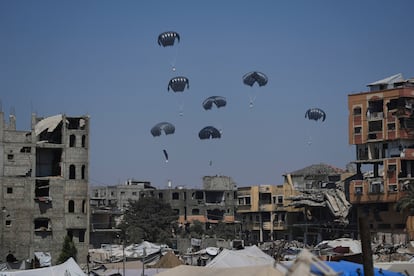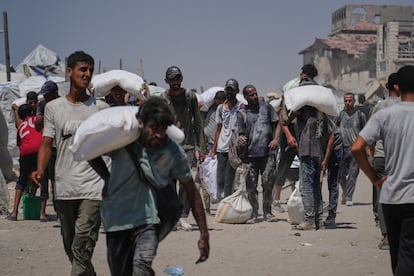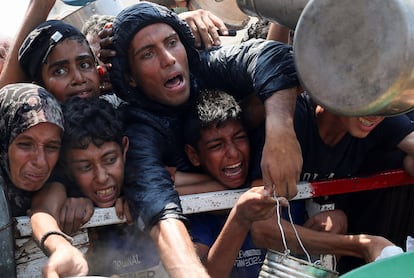The UN will try to take advantage of the pause in attacks announced by Israel to assist the starving population in Gaza.

United Nations teams in Gaza "will try to assist as many hungry people as possible " during the so-called humanitarian pauses announced by Israel, which are expected to continue through Monday. This is the main message from the organization's head of Humanitarian Affairs, Tom Fletcher, in response to the minimal relief announced this Sunday by the Israeli army, which involves allowing more aid to enter through safe routes. A few hours after this Israeli announcement, the first gesture of easing tensions following the global alarm generated by hunger in the Strip, testimonies from the Strip collected by this newspaper indicated that no change in the situation or improvement in the population's access to food had yet been noticed.
Beyond the partial humanitarian pause in three areas of Gaza , the UN continues to urge the Israeli government to allow access to sufficient supplies to prevent the imminent human cataclysm caused by hunger in Gaza, a catastrophe that neither the entry of a limited number of food trucks nor the controversial airdrops of food, which began this Sunday, will be able to avert. "We don't just need words, we also need actions . We need very rapid authorizations and approvals," summarized Ross Smith, head of the UN World Food Program (WFP), this Sunday.

The United Nations thus reaffirms a conviction it has expressed for months: that without a massive influx and distribution of food, water, fuel, medical supplies, and equipment, the risk of starvation looming over a large portion of the 2.1 million Palestinians in the Gaza Strip will be almost permanent. Around 470,000 Gazans are already eking out a living "in famine-like conditions," the organization's World Food Program denounced again this Sunday.
This situation is so serious that it hardly seems irreversible. The United Nations has repeatedly alluded to the difficulty of reversing the deterioration this July, when around half of the 133 Palestinians who died of starvation in the Gaza Strip, many of them children, died.
Gazan Amjad Shawa, director of the network of 135 NGOs operating in the enclave under the UN-led humanitarian system, stressed two key factors by telephone from the Gaza Strip on Saturday, shortly before the Israeli decision to ease the blockade was announced: first, the time pressure for this population, which is on the brink of famine. Second, the possibility that Israel will allow aid to enter to appease the growing chorus of international calls, but that these supplies will then remain on the Gaza side of the border, without reaching a population where a third of its inhabitants—around 700,000 people—go days without eating, according to the WFP.

“Israel has deceived the world about aid,” the Palestinian aid worker emphasized from Gaza City. Until Saturday, Israeli authorities had only allowed the entry of “between 3% and 5% of the humanitarian cargo the enclave requires,” a need Shawa estimated at 1,000 trucks per day.
During the truce, he specified, the Gaza Strip required 600 trucks per day, but that number is now higher due to "the catastrophe and the unprecedented conditions" the Palestinian territory is experiencing. The United Nations has already warned, for example, that to save many Gazans suffering from severe acute malnutrition, especially children, it is no longer enough to simply give them food. They will require specialized treatment.
"Yes, aid enters Gaza, but Israel restricts access to these trucks from the Palestinian side of the wall, which is completely controlled by the Israelis," the local aid worker emphasized.
Shawa expressed another fear: the deterioration of coexistence in the invaded Palestinian territory. The starving and decimated Gazan population, forced to concentrate in humiliating and unsanitary conditions in 12% of Gaza's 365 square kilometers, is experiencing an increase in violent disputes. The context is one of hunger and the struggle for survival that sometimes forces them to fight to access paltry amounts of food.

"Israel is creating chaos," the aid worker lamented, referring to earlier images similar to those released this Sunday after the first pallets of food dropped from the sky touched down in Gaza. They showed men fighting over some of the food loaded in the first airdrop. Other photographs showed crowds surrounding the first flour trucks authorized by Israel to enter a territory where Israeli attacks have already killed nearly 60,000 people since October 2023.
A concessionAlthough insufficient, Israel's decision on Saturday to authorize what it called "pauses" and "humanitarian corridors" constitutes a first concession in a siege often described as medieval. The announcement was weighted heavily by images of children consumed, with only bones left under their skin, to which political leaders such as Australian Prime Minister Anthony Albanese have alluded . In a virtually unprecedented rebuke, several European governments last week accused Israel of blocking the entry of aid.
Throughout much of its ongoing invasion of Gaza, the Israeli government has blocked or restricted aid to the Strip, claiming, without providing evidence, that Hamas was monopolizing supplies distributed under the UN umbrella. According to this theory, this alleged diversion of aid allows Hamas to control the population and maintain its hold on power.
On Friday, an investigation published by the United States Agency for International Development (USAID) refuted that claim, stating that there is no evidence that this has happened systematically. On Saturday, hours before Israel announced the measures to ease the blockade, The New York Times, citing sources within the Israeli military, reported that an internal investigation into the matter had reached the same conclusion.
EL PAÍS





